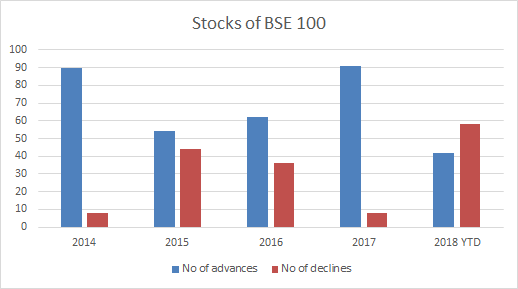In 2018 thus far, equity markets stood out for one peculiarity. A few stocks kept the index up while the broader market lagged behind. Since the index constituents are weighted by market-cap, price movement in larger companies will have a bigger impact on the index. With the market favouring these companies, benchmark index – Sensex (which has just the top 30 stocks) is at much higher levels than the broader market. The graph below shows how Sensex has gradually diverged from BSE 100 and BSE 500 during the year. In this article, we look at what the market was like in 2017 and what is leading to money being concentrated in a few stocks at the top now.

What is different about this market
The graph above shows the number of stocks in BSE 100 that moved up (advances) and moved down (declines) for the past 5 years and the table shows the returns of the index. We can see that in all the other years, the index movement is in line with movement of majority of the stocks, barring a marginal difference in 2015. But this year, even though the index has returned 1.3% until now, more number of stocks have actually declined. What happened last year gives us a clue about what just transpired.

A quick flashback to 2017
Calendar year 2017 not only gave enormous returns for its equity investors but also did so indiscriminately. During that period, Sensex was up 28%. And in the stocks that constituted BSE 100, 91 stocks gave positive returns while only 9 were in the negative territory. The run up in 2017 was because of abundant liquidity in the market and strong positive sentiments that prevailed. While it was a good thing for the market, some stocks that were not quite backed by sound fundamentals also got a free ride in this momentum led rally.
Weeding out the lemons
After a year like 2017 where market breadth showed robust uptrend, valuations became a concern. A number of stocks were at an all-time high which translated into exceptional returns for them. From then, the challenge has been to distinguish quality stocks from the stocks which just ran up with the market momentum. This is similar to the famous lemons problem posed by economist George Akerlof.
The lemons theory is often explained using the example of an used car market. There are two types of sellers available in the market – one who sells good quality cars and one who sells bad quality ones (termed as lemons). For a buyer, it is difficult to differentiate between the both. As a result, the buyer will be willing to pay a price which is below the price of a good car and above the price of a bad car. The seller who sells bad quality ones will benefit by getting a higher price than what it’s worth. This is what they call the information asymmetry bias. Because the buyer doesn’t have information about what is good, he is not able to take the right pricing decision.
Now, how does it relate to the stock market?
Like in any other market, even in stock market there are informed investors as well uninformed ones. The perceived value of stocks will be different for these players. Since there is asymmetry of information between them, some ‘lemons’ are bought at higher prices pushing them up. This happened in the 2017 market. In other words, a number of stocks rose to prices that were higher than their underlying value.
Current market
As valuations became more stiff, fear set in that the overpriced lemons might come crashing down. Faced with such a situation, what the market decided to do by early 2018 was to simply stick to higher quality stocks to avoid buying a lemon. This drastically cut down the number of stocks that were sought by buyers. Only a few stocks with perceived sound fundamentals, were bought. This cautious approach led too much money chasing a few stocks at the top driving them up while other stocks faced a correction. In other words from overpriced lemons, markets went to a state of polarised stock returns where few stocks delivered and the rest languished.
However, even this appears to be reversing now. The correction in the last one month is also hinting at unsustainability of such polarised returns. Sensex is down 6% in the past month reflecting a better picture of the market. From lemons to polarised valuations to a more sane correction, the market perhaps is coming a full circle. Would there be buying opportunities in this? That’s a discussion for later.







